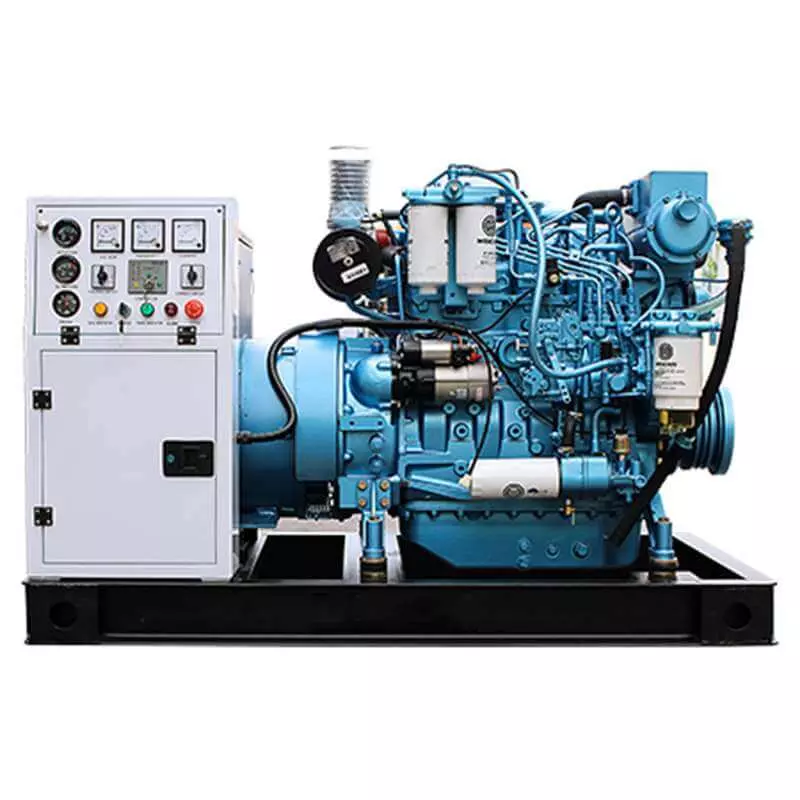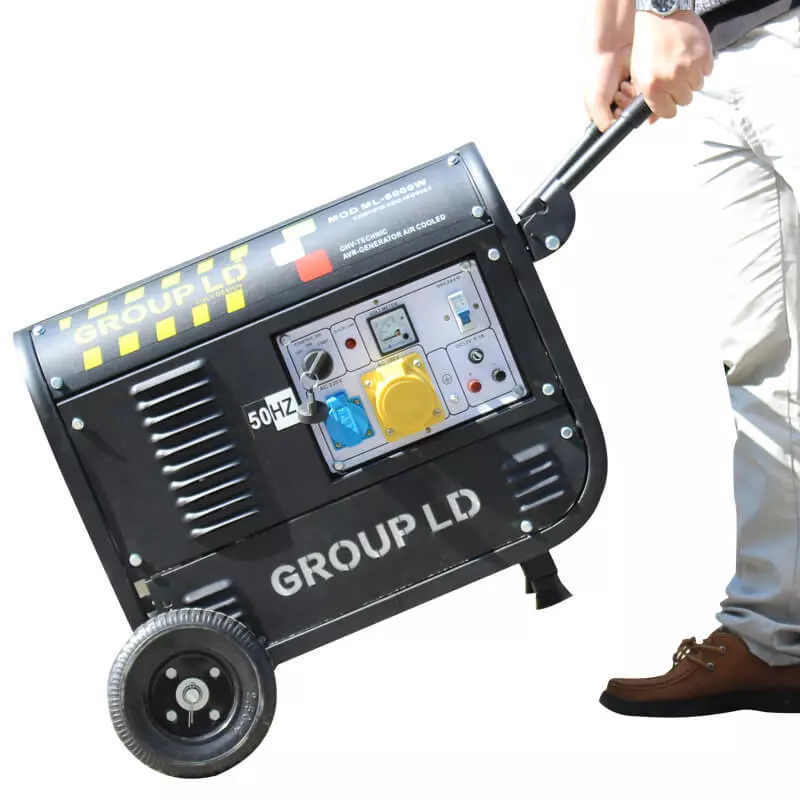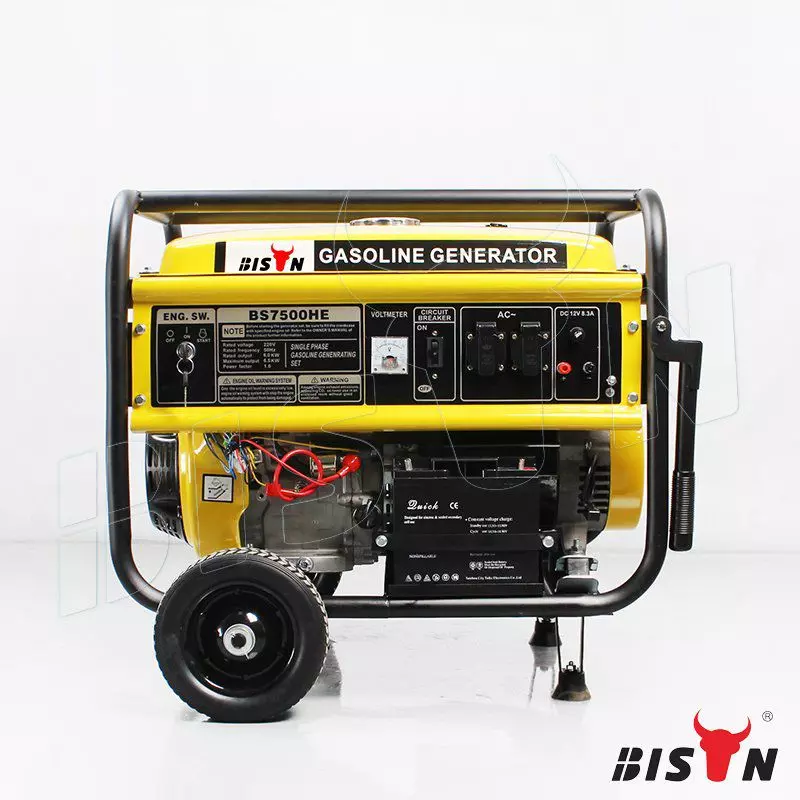How to start a generator?
2022-10-21
Table of content

How to start a generator
You need your portable generator to start up promptly in case a storm knocks out your electricity.
You probably bought your generator a few years ago but don’t remember how to start it. But when a power outage cripples a nearby area, you want power back as quickly as possible.
Please read these instructions to know how to start a generator when you need it most.
Step-by-step instructions on how to start a generator
1. Consult your user manual
People hate reading the owner’s manual. But each product has a unique operating procedure. So check your manual to make sure the generator is assembled correctly, and you know how to start it properly.
2. Check for gas leaks
If a storm hits your building, checking for damage and gas leaks is a good idea.
3. Bring your generator outside and away from your home
Operate your generator outside, at least 15 feet away from your house. Never operate a generator in your home, shed, or garage. If you use a generator in your garage, you could die from carbon monoxide poisoning within minutes.
4. Do not operate the generator in a storm
Heavy rain can cause electric shock and damage to the engine. You can, however, buy a generator tent to help shield your generator from inclement weather if you must use it when it is raining.

Generator tent
5. Check the oil and gas levels
If you use gasoline to fuel your portable generator. Always make sure to fill the generator with fresh gasoline. Over time, the ethanol in the gas will absorb moisture. Not only will stale gasoline make starting more difficult or impossible, but it can also damage the engine. Also, check the generator oil level to ensure the engine is properly lubricated. Add oil to the specified line on the generator.
6. Remove all wires plugged into the generator
Disconnect all power cords before starting the generator. It would be best to start the generator before connecting it to your home. You don’t want to attach any load during startup.
7. Open the fuel valve
Open the fuel valve. When the fuel valve is released, fuel flows to the carburettor to help the generator start.
8. Open the choke
Moving the choke lever from right to left makes it easier for the engine to start running.
9. Turn on the ignition switch (or engine switch)
Many generators require you to flip a switch to turn on the engine. This is essentially an engine switch that turns on before you pull the recoil cord.

Pull cord
You can start your generator without using the recoil wire if it has an electric start button. Your battery may be dead if the electric starter doesn’t operate. To fix this, you can use a trickle charger to charge the battery.

Electric start button
10. Pull the recoil rope
When you pull the recoil rope, you are starting the engine. Pull the recoil rope until you feel a little resistance, then put it back on. If the engine does not start, try pulling the cord again.
If the engine does not start, move the choke to “half-run” and pull the rope again.
11. After the engine starts, move the engine choke to “RUN”
After running the engine for a while, you can move the choke back to the “run” position.
12. Turn on the circuit breaker
Before connecting any electrical cords, let the generator run for a few minutes. Also, make sure you have the circuit breaker turned on. After running for 3-5 minutes, you can start connecting it to the house. There are a few ways to regain your strength:
a) Extension cords
When you use an extension cord, it must be the right gauge. Larger-gauge extension cords are suitable for light-duty equipment, and smaller-gauge extension cords are suitable for heavy-duty equipment.
If you’re powering Christmas lights or something like that, a lightweight 16-gauge extension cord will do just fine. But these lightweight power cords are a fire hazard for most of the equipment you’ll be plugging into a generator.
For most items, you’ll need at least a heavy-duty 12-gauge extension cord or an extra-heavy-duty 10-gauge extension cord. For example, a 10-gauge extension cord is perfect for your refrigerator.
b) Convenient cords
Simple convenience cord is another option, which allows you to insert multiple items at once. Instead of plugging a single device into the generator, you plug in this power cord, extend it where most of the devices are, and plug in multiple devices from there.
c) Power cord and transfer switch
Finally, the manual transfer switch can also be used with a generator power cable. This option may require more initial setup time and cost more upfront. However, it makes your generator operation easier and faster in the long run.
Instead of using extension cords to power individual devices, transfer switches allow you to power critical loads on circuit boards in your home.
So that means you can use generator power to run hardwired household appliances, such as ceiling fans. This makes generator power cords a convenient, long-term solution.
Power cords come in different amperage sizes, such as 20-Amp, 30-Amp, and 50-Amp. It would be best if you chose a generator cord that matches the most powerful outlet on the generator.
So if you have a 50 amp outlet, you will need a 50 amp power cord. When you look at the power cord, you will notice that the two ends are configured differently. The “male” end has a straight blade plug extending out. You plug that end of the wire into the generator. The “female” end is a connector that fits into a power entry box outside your home.
First-time generator start-up instructions (new generator)
If you just purchased your generator, you may want to add oil to it and ensure everything is connected properly (see the owner’s manual for setup). After filling up with oil and fresh petrol, you need to start it safely by following the proper steps.
Here are the steps to start a brand new generator:
● Turn off the breaker
● Gas valve should be turned ON / OPEN
● The choke should be closed (turn the handle or push the button)
● Start the generator
● After the generator has warmed up, you can now open the choke (or put it in the closed position)
● Turn on the breakers
● Connect the required equipment
Choke closing/opening can be quite confusing as different manufacturers use different terms to describe the same thing. Here are some common variants:
● Choke OPEN
● Choke CLOSED
● Choke ON
● Choke OFF
● Choke RUN
● Choke START
How to start a generator after a prolonged period of inactivity
Now let’s consider the case of using the generator after a long interval. In addition to what we’ve covered above, you’ll need to take an extra step every time you run your generator idle for an extended period of time.
a) Checking the oil level
All premium generators are equipped with a low oil level sensor and automatic shutdown. It is still recommended to use a dipstick to check that there is enough oil to operate. Please fill in if required.
b) Check the fuel level
Check the fuel level with the fuel gauge. Many fuel gauges won’t work if the fuel level is less than one-third of the tank’s capacity. If old fuel is left in the generator for more than a month without the proper fuel stabilizer, it can permanently damage the fuel system. After removing stale gasoline or any other stored fuel, perform a proper cleaning of the carburettor (using a carburetor cleaner), fuel valve, fuel filter, and fuel lines.
c) Check the air filter
The generator’s air filter may contain debris or dirt from previous use and may not provide enough air for combustion.Replace them if they become clogged or dirty.
d) Check the spark plugs
Check the condition of the spark plugs and clean them if found dirty.
How to stop a generator
After you’ve used the generator, it’s important to perform the proper process of shutting down the generator.
Here are some easy steps to do that.
1) Turn off any appliances/tools plugged into any outlet on the generator.
2) Unplug any appliances/tools plugged into any outlet on the generator.
3) Switch the generator to the “off” position. Your generator will now have no power.
4) Turn the fuel tap so that the handle on the top points to the “left.” The fuel supply is now off.
5) If you are using a portable generator, then store it in a safe place after shutting it down.
The do’s and don’ts of starting or turning on a generator
Special care is required every time a generator is used. This way, you can avoid accidents, and it will serve you for a long time. Best practices include the following:
a) The do’s
● Plan ahead for the power required by the generator to avoid overwork. The safest strategy is to have a generator that produces more power than you need. About 1.5 times the power you need is the best option. This is because every time a new load is added to it, it is stressed to match the new power supply being used.
● Always have some extra fuel on hand for emergencies. You never know how long a power outage during a storm will last.
● Always use generators with care. This includes refuelling only when the generator is off and cooled down and refuelling when there are no flames around.
● Keep the power cord in good condition. Check their actual wattage ratings, then always keep them properly insulated and grounded to reduce the risk of electric shock. Protect them from sunlight and other harsh conditions, as these can shorten their lifespan. Always check the integrity of the cables beforehand every time you need to start the generator.
● Always keep the manual handy when you’re dealing with a problem you don’t know about. This will save you a lot of pain and cost.
b) The don’ts
● Never use a generator indoors. Placing it at least 15 feet away from any home is your best bet to avoid suffocation from carbon monoxide released by generators. Also, any covering you use on the generator should have at least 4 feet of clearance from it.
● Never use your generator in wet conditions. This will only increase the likelihood of electric shock and damage to the generator. So keep it covered and away from the ground at all times.
● Do not start a generator with your home’s power cord connected. This can damage your electronics due to power surges. It is best to wait until the engine sound stabilizes before plugging in the power cord.
FAQs
1) How long does it take for the generator to start?
Your generator will boot up and switch to your home’s power within 10-20 seconds. You’ll see that the generator starts up, runs for a little while, then switches.
2) How can I tell if my generator is flooded?
Removing the spark plugs is the easiest way to tell if your engine is full of gas. If it’s wet, it’s flooded, and you need to let the cylinder dry out before trying to restart it. Compressed air can help speed up the process.
3) What is the purpose of a choke coil?
Its purpose is to restrict air flow, thereby enriching the fuel-air mixture when starting the engine.
4) What happens if I open the choke?
Leaving the choke open for too long can cause unnecessary engine wear and waste fuel. It’s also bad for the environment. Chokes are mainly used to help start in winter. The engine needs to vaporize its fuel in order to burn.
Conclusion
This article is not intended to replace your generator owner’s manual. However, every effort has been made to ensure that the information provided is accurate. Always start the generator in the correct way to ensure its efficient operation.




